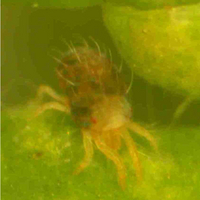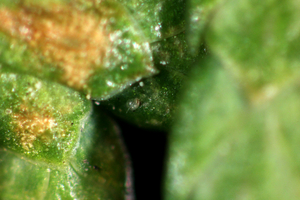Spruce spider mite
Oligonychus ununguis
Appearance
The adult conifer spider mites are up to 0.6 mm long, have eight legs and an oval body shape. Due to their intestinal contents, the originally pink-coloured mites often appear dark green. They move quickly with characteristic trembling movements. Under the microscope, their legs show the claws and bristles that are very characteristic of spider mites. To feed, they pierce the needle tissue of their host plants with their stylet-shaped mouthparts and suck out the cells of the uppermost layers of tissue.
The eggs of the conifer spider mite are onion-shaped, 0.15 mm in size and orange-red to brown in colour. A special feature is a short stalk on the outer pole.



Biology
On firs and spruces the eggs are laid at the base of the needles, on thujas they are preferably found in grooves and in protected areas of the scale leaves. The mites overwinter as eggs, which are very resistant to the cold. After hatching, the empty egg cases often remain. Larvae have three pairs of legs, later they moult into so-called nymphs, which have four pairs of legs.
Like other spider mite species, the conifer spider mite can also produce very fine webs that surround the suckers of heavily infested leaves. However, such webs are rarely found in the wild - and they are rarely very pronounced. They probably serve mainly to protect the mites from their predators, such as lacewings, special species of ladybirds (e.g. Stethorus and Scymnus species), flower bugs(Anthocorus and Orius species) and predatory mites(Typhlodromus sp.). Only when these natural enemies can no longer do their job does mass reproduction set in.
The mite can reproduce particularly well in dry years. Under such conditions, damage that has already occurred becomes more noticeable. Depending on the ambient temperature, the development cycle is completed in a short time (in just 15 days at correspondingly high temperatures), so that several generations can emerge each year. As each female mite lays around 50 eggs, the mites can reproduce very quickly throughout the year under favourable weather conditions, starting as early as mid-March.
Damage symptoms

The mites sting superficial plant cells - these turn yellow and die. Infested thujas' scale leaves show a mottled appearance close up, from a distance they look dull green. Heavily infested thujas turn brown and can dry out. In the course of mass development, the mites slowly migrate from heavily infested areas to healthy tree areas.
In conifers, the sucking activity, which usually begins in the centre of the crown, causes the affected needles to dry out and fall off in heavily infested areas. This damage is often confused with drought damage due to a lack of water. A magnifying glass, or even better a stereomicroscope, is essential for an accurate diagnosis. This is because usually only empty egg cases or moulting remains can be seen in the abandoned infested areas.
An infestation lasting several years can considerably weaken young trees and cause them to die.
Prevention and control
- Sufficient irrigation in dry locations
- Avoid dense growth and over-fertilisation
- There are a number of highly effective agents available for the chemical control of spider mites (=acaricides) (see list of plant protection products authorised in Austria)
- Many agents are only slightly effective against some mite stages (e.g. eggs). However, as there is always a mixture of mites from all stages of development, two treatments should be carried out seven to ten days apart
- Winter eggs: spraying with oily preparations is recommended.
Last updated: 10.03.2025
automatically translated